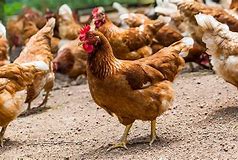|
What Is Bird Flu (avian influenza) By Pierre Mouchette | Bits-n-Pieces Bird flu (avian influenza) is a virus infection spread from bird to bird. The most common kind of bird flu is the H5N1 strain. It is primarily a threat to birds and does not spread easily among people. The pattern of human transmission remains unexplained. In rare instances, bird flu has been transmitted from one human to another. However, unless the virus begins to spread more easily among people, infected birds present the most significant hazard.
Public health authorities worry that a global epidemic may occur if the virus transforms into a form that transmits more easily from person to person. Scientists are working on vaccines to help protect people from bird flu. Causes of Bird Flu Bird flu occurs naturally in wild waterfowl and can spread to domestic poultry, such as chickens, turkeys, ducks, and geese. The disease can spread through contact with an infected bird's feathers, feces, or secretions from its nose, mouth, or eyes. Undercooked poultry meat and eggs from the infected birds can transmit bird flu. Poultry meat is safe to eat if cooked to an internal temperature of 165 F. Eggs must be cooked until the yolks and whites are firm. People catch bird flu by close contact with birds or bird droppings. In the 2014 outbreak, some people caught H5N1 from cleaning or plucking infected birds. There are also reports of infection via inhalation of aerosolized materials in live bird markets in China. It is also likely that some people were infected after swimming or bathing in water contaminated with the droppings of infected birds. What Are the Symptoms of Bird Flu? Bird flu symptoms in people can vary. But, the signs and symptoms of bird flu usually begin within two to seven days of infection, depending on the type. The illness could start with flu-like symptoms, including fever, cough, sore throat, headache, and muscle aches. But it may worsen to include:
Complications Individuals with bird flu can develop life-threatening complications, including:
When You Should See Your Doctor Consult your doctor immediately if you get fever, cough, and body aches and recently traveled to a part of the world where bird flu occurs. Inform your doctor if you visited any farms or open-air markets. Recommendations for travelers If you are traveling to Southeast Asia or any region with bird flu outbreaks, consider these public health recommendations:
Comments are closed.
|
Archives
May 2024
|
